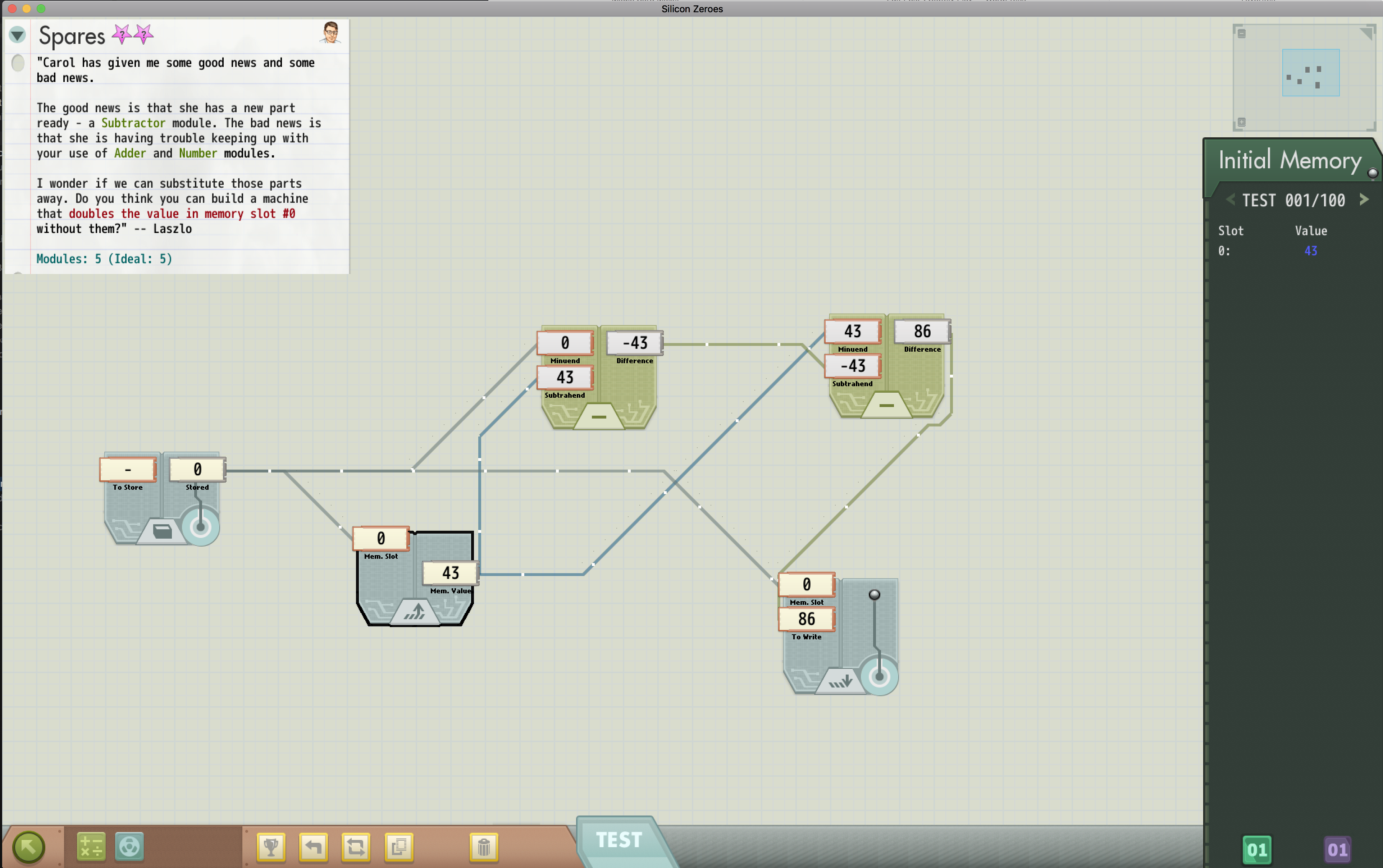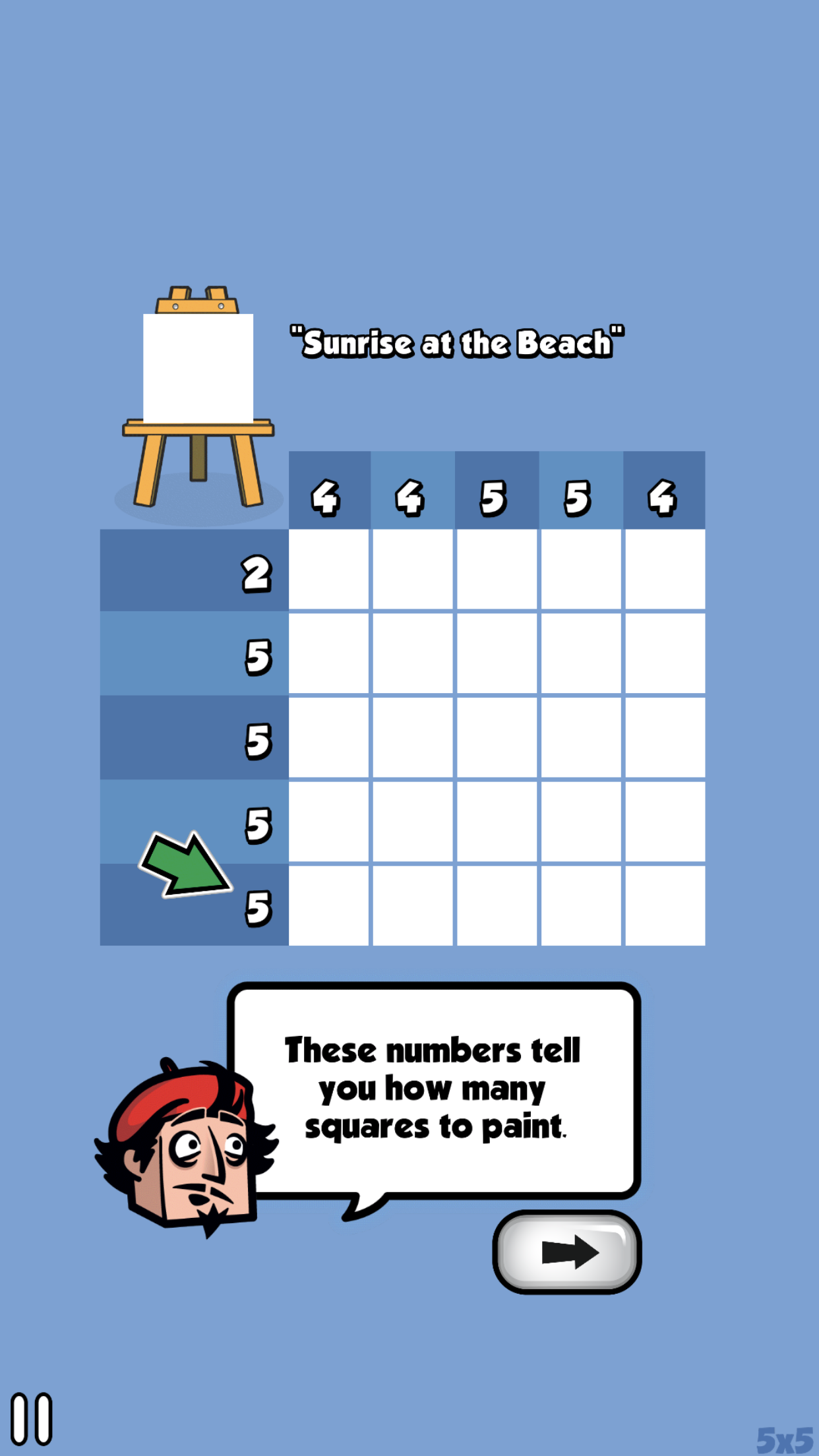Steam •
In which the author addresses the greatest philosophical problems in gaming
I tried to do a brief look at Silicon Zeroes, the easy chair of the programming game mini-genre, but, like Proust’s madeleine biscuit*, a single level touched off a bunch of related thoughts I needed to address. But SZ deserves at least a brief overview: if you’re familiar with Human Resource Machine or TIS-100P, you’ve seen the basic idea before: simple programming tasks are basically just puzzles, anyway, so folks have started turning them into puzzle games. SZ does so more comfortably than most, with an easily-grasped interface and helpful features like the ability to bundle a code segment into a reusable chunk. But it also includes the level in question: a problem in which you’re briefly denied access to one of the functions you’ve been using (subtraction), and have to build something to accomplish the same goal. Months later, I think I have an idea of how to understand the intellectual product which makes games distinct from other art forms, and which tracks my intuitions about intellectual property. Though you might have different intuitions, we’ll at least be able to disagree more specifically.
What enchanted me about this level is that metaphysicians (whom my physician wife insists ought to be called “metaphysicists”) friggin’ love demonstrating that something you thought you needed to just accept can be understood as a combination of other stuff. Accepting the existence of something which cannot be explained in terms of anything else exacts a terrible toll on the mind of a metaphysician–we don’t actually want to explain much of anything anyone cares about, admittedly, but we like demonstrating that we could explain everything if we wanted to. That’s basically what the most historically popular formulation of Ockham’s Razor comes down to: “Do not multiply entities without necessity” (that formulation apparently comes from John Punch’s commentary on Duns Scotus, opponents of whom gave us the modern meaning of the word “dunce”. Of those two men, it’s hard not to be surprised at which one gave his name to a modern word). So, as a recovering metaphysician, I adored the abovementioned puzzle from Silicon Zeroes, and it left me in a philosophical mood as I pondered why I was so happy with a game which was, in its basic structure, so similar to existing programming games. With Human Resource Machine, I’d told myself that it was mostly presentation–the addition of characters who looked like they’d be at home in The Numberlys seemed like an important step toward making such games appealing to a broader audience. But, here, it’s largely interface and puzzle selection, rather than the underlying structure of the puzzles.

That got me thinking about the underlying structure of programming. Lots of programming languages can perform all computable functions (they’re called “Turing-complete”), they just give users different methods of telling the computer how to go about it. So, in terms of their capabilities, the only relevant limits have to do with memory and speed. But the experience of using two Turing-complete languages to perform the same task is often wildly different. Similarly, even when two puzzle games have a structure which allows the presentation of functionally identical puzzles, differences in interface and which puzzles are presented in which order can massively alter what it’s like to play them. At the highest level, we can think of this as dramaturgy**. When I first worked through the exercises in Hyperproof***, I was astonished by how thoughtfully the puzzles were chosen–a careful reader who did every exercise would gradually be brought to a very high degree of skill in generating proofs, without tedious repetition or major spikes in difficulty. The story the program told was that formal logic was intuitive, easy to grasp, and enjoyable. Another example: Paint It Back is just nicely-presented picross, with a surprising amount of personality in its pixels.
Paint It Back takes an existing rule set for creating puzzles and just churns out more, rather than making any contribution to formal game design. It seems as though that ought to bother me, but it doesn’t. Admittedly, nobody seems to have a very good handle on what counts as innovation in games (which has gotten some people understandably cheesed). This piece by David Sirlin, posted to Penny Arcade a while back, pretty well sums up what I take to be the received wisdom on the issue, complete with a huge amount of uncertainty. Basically, he suggests that, while you can’t copy art assets, and you shouldn’t copy gameplay exactly, there’s a lot of room for even minor rule changes to do something important we want to encourage. He’s understandably vague about the nature of that something. But examples like Paint It Back suggest that even minor rule changes need not be necessary if enough of the experience is generated by choices made outside of the rules.

What even counts as “the rules” is negotiable. Race for the Galaxy is often panned for over-reliance on icons defined in the rules, but the effects of those cards could simply be written on them, instead, and the rules could be abbreviated. The digital version basically offers both. Magic: the Gathering has a long history of choosing to make some common abilities keywords, which are defined in the rules but also on the cards themselves if there’s space. Sometimes these choices can make a big difference to the experience. Reiner Knizia’s Tigris and Euphrates gives us the classic example: players collect points in various categories, but only score their lowest category. This is usually experienced as novel and interesting, but it’s mathematically identical to scoring sets of one of each. When I read this observation on Boardgamegeek, years ago, I felt sadly deflated, and have never since been quite as impressed by T&E.
So, consider whatever implements a game: the code and art assets, or rules and physical components: whatever these are, they constitute the lowest level of analysis of the game. We can describe the same game in terms of the sorts of experiences it tends to produce in players, just as we can describe an organism in terms of its basic physics, chemistry, or biology, each time using different concepts, but all the while referring to the same subject. What I adore most about games is a thoughtful connection between the implementation and the experience. The design of all those components of implementation in order to produce gameplay dynamics which have an intended effect–that’s an art which no other art form replicates.
It’s also what I would seek to protect, and I think I have a pretty reliable way to test for it: playtesting not just for functionality, but experience. If the people who made a game don’t have to test whether the game’s implementation tends to produce the desired experiences, they have not contributed the intellectual work unique to the art of game creation. I like that this puts often-unsung playtesters in a position of importance, but the point isn’t that playtesting itself is what matters to me. Rather, the need for playtesting is an indicator that the team has tried something new to them with the game-specific creative process. As mentioned above, this might not capture what you value, but it helps me decide when I should feel uncomfortable supporting the team behind a game.
• Silicon Zeroes on Steam, $15
* I’ve never read Remembrance of Things Past, or any other Proust. Like most educated people, I’ve just heard it referred to as a ten-volume novel entirely composed of ruminations and vivid recollections touched off by a single olfactory sensation. [and if you’re like me, you’ve only heard that because Monty Python referenced it all the time -ed.]
** I am grateful to Clio’s Board Games for introducing me to this concept. So now I really sound like I’m just faking all my knowledge. But, hey, I was pretty sure that Clio was the muse of history before I even looked it up, so I paid attention in tenth grade English class.
*** Okay, now I can totally reclaim my credibility by noting that I was overjoyed to learn that Hyperproof is available again! It was Mac OS 9-only for years and years. I’m honestly considering buying a textbook on logic just so I can play through the whole thing. My daughter sounds pretty excited to learn it, which probably makes you wonder about my parenting.



Neat. Nice article. I was intrigued by Silicon Zeroes, but while TIS-100 and Shenzhen I/O both captured my attention for a little while, ultimately I couldn’t force my way through them, so I passed on this one.
Stately Play article with footnotes. Wait til I tell the boys about this wet dream come true.
The closest I’ve ever come to these types of logic-based experiences would be Carnage Heart. Robotics keeps a dunce enthusiastic.
You’d triggered a re-download of CH. Good one, Kelsey.
Whoa, never heard of this one before. Heading to emuparadise…
It never even occurred to me that a test to see if a game was different from another would be experiential in nature, probably by necessity. I feel a little stupid now.
I’m not entirely sure the board game experience is beyond quantifiable and I’m not sure if this cheers me up or not. Thinking of the sort of metrics you’d use makes my head hurt, but perhaps it is reassuring that it’s measurable somehow, even if I am too dim to work out the method.
Curse you, @OhBollox! Now I want to write a companion post explaining how I went down a long road of trying to identify a more objective measure. It was a fun journey for me, but too abstruse and academic for this post. Which is saying something.
I am sure it can be done, I’m just not sure it’s practicable. It’ll be a long time, if ever, before it’s something that’s going to be really useful to inform designers. Nevertheless, I think board gaming by its very nature is quite fragile, and it would be easy to isolate the big factors.